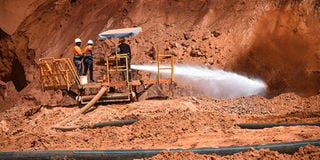Confusion hits miners after mineral royalties declared unlawful

A mining site at Kenya's coast. Confusion has hit the mining sector after a section of the law that sets royalty charges on minerals was declared unconstitutional, dealing a setback to the State and communities that look up to sharing the wealth from the natural resources.
Confusion has hit the mining sector after a section of the law that sets royalty charges on minerals was declared unconstitutional, dealing a setback to the State and communities that look up to sharing the wealth from the natural resources.
High Court judge Hedwig Imbosa Ong'udi made the findings following a petition by a mineral prospecting company, Rockland Kenya Limited which had challenged levies imposed on its mining business by the Petroleum and Mining Ministry in 2019.
The company, which runs mining operations within Tsavo West National Park, said Section 183 of the Mining Act 2016—popularly referred to as the Mining (Prescription of Royalties on Minerals) Regulations 2013—was set without public participation as required by Article 10 of Constitution on the involvement of the citizens in the country’s governance.
The High Court agreed with Rockland Kenya Limited that the Mining (Prescription of Royalties on Minerals) Regulations 2013 were not subjected to public participation in line with Section 5(2) and (3) of the Statutory Instruments Act. This Section requires notification for public participation in the exercise and an invite to submit comments.
“As a result, failure to uphold this Constitutional requirement renders the Mining (Prescription of Royalties on Minerals) Regulations 2013 unconstitutional” Justice Ong'udi said.
Rockland in an affidavit backed by former Machakos Senator Johnson Muthama pointed out that the regulations came into effect vide Legal Notice No.187 of 2013 on August 16, 2013, while the Statutory Instruments Act 2013 came into effect on January 25, 2013—meaning that the rules should have been subject to the public participation requirements of the Statutory Instruments Act.
Miners told Nation that the ruling has caused confusion in the sector amid uncertainty in their tax transactions.
"Wait-and-see"
“It is now about wait-and-see on what the government will say next,” an official of a mining company said.
The Mining (Prescription of Royalties on Minerals) Regulations 2013 were published by then Mining Cabinet Secretary Najib Balala. The rules set the royalty rates on the sale value of diamonds at 12 per cent, rare earth elements and radioactive minerals (10 per cent), niobium (10 per cent), titanium ores and Zircon (10 per cent), coal(8 per cent) and five per cent for gemstones.
It also set an eight per cent royalty on the gross value of metallic ores, iron ores, manganese ore, chromium ore, nickel ore, bauxite, and other ores.
Further, the regulations set a five per cent royalty charge on the gross sales value for fluorspar, diatomite, natural carbon dioxide gas, and all other minerals; one per cent for industrial minerals including gypsum, limestone, and silica sand; and two per cent value for construction material while exported gold attracts a two per cent charge.
Section 183 of the Mining Act, 2016 provides that any holder of a mineral right shall pay royalties to the arising cumulative revenue would then be shared amongst the national government, beneficiary counties, and communities.
Official data shows that by June 2022, at least Sh7.5 billion had been collected from mineral royalties. This means that the Treasury is holding Sh1.5 billion million for the counties and Sh750.39 million for the communities where minerals were exploited. The balance of Sh5.25 billion (70 per cent) is the share of the national government.
The sharing of this wealth hasn’t been done amid a legal lacuna. Whereas a framework for sharing the mineral royalty revenue among the national government, county governments, and communities were developed, Attorney General Justin Muturi’s office in December advised the development of subsidiary regulations to the Mining Act to provide the mechanism for the transfer of these mineral royalties to the communities.





